
Operating instructions for
KL3041, KL3042 and KL3044
Single-, Two- and Four-Channel Analog Input Terminals
Measuring range: 0 to 20 mA
and
KL3051, KL3052 and KL3054
Single-, Two- and Four-Channel Analog Input Terminals
Measuring range: 4 to 20 mA
Version: 3.2
Date: 2006-10-12

Table of contents
KL304x and KL305x
Table of contents
1. Foreword 1
Safety Instructions 1
Copyright 1
2. Technical data 2
3. Connection 2
KL3041 and KL3051 2
KL3042 and KL3052 3
KL3044 and KL3054 3
4. Functional description 4
5. Terminal configuration 6
6. Register Description 7
General Description of Registers 7
Terminal-specific register description 10
Control and Status byte 13
Register communication 14
7. Appendix 16
Mapping 16
Register Table 19
Support and Service 20

Foreword
KL304x and KL305x 1
Foreword
Safety Instructions
Personnel Qualification
This description is only intended for the use of trained specialists in control
and automation engineering who are familiar with the applicable national
standards. It is essential that the following notes and explanations are
followed when installing and commissioning these components.
Liability Conditions
The responsible staff must ensure that the application or use of the
products described satisfy all the requirements for safety, including all the
relevant laws, regulations, guidelines and standards.
The documentation has been prepared with care. The products described
are, however, constantly under development. For that reason the
documentation is not in every case checked for consistency with
performance data, standards or other characteristics. None of the
statements of this manual represents a guarantee (Garantie) in the
meaning of § 443 BGB of the German Civil Code or a statement about the
contractually expected fitness for a particular purpose in the meaning of
§ 434 par. 1 sentence 1 BGB. In the event that it contains technical or
editorial errors, we retain the right to make alterations at any time and
without warning. No claims for the modification of products that have
already been supplied may be made on the basis of the data, diagrams
and descriptions in this documentation.
State at Delivery
All the components are supplied in particular hardware and software
configurations appropriate for the application. Modifications to hardware or
software configurations other than those described in the documentation
are not permitted, and nullify the liability of Elektro BECKHOFF GmbH.
Copyright
© This documentation is copyrighted. Any reproduction or third party use of
this publication, whether in whole or in part, without the written permission
of Elektro BECKHOFF GmbH, is forbidden.

Technical data
2 KL304x and KL305x
Technical data
Technical data
KL3041 KL3051 KL3042 KL3052 KL3044 KL3054
Number of inputs
1 1 2 2 4 4
Power supply
24 V
DC
via the power contacts
Signal current
0..20mA 4..20mA 0..20mA 4..20mA 0..20mA 4..20mA
Internal resistance
typically 80 Ω + diode voltage 0.7V
Surge voltage resistance
35 V max.
Resolution
12 bits
Conversion time
~ 1 ms ~ 2 ms ~ 4 ms
Meas. error (total meas. range)
< ± 0.3% (of the full scale value)
Electrical isolation
500 V
rms
(K-Bus/signal voltage)
Current consumption from K-Bus
typically 65 mA
Bits width in process image
Input: 1 x 16 bits of
data
(1 x 8 bit
control/status
optional)
Input: 2 x 16 bits of
data
(2 x 8 bit
control/status
optional)
Input: 4 x 16 bits of
data
(4 x 8 bit
control/status
optional)
Configuration
no address or configuration settings
Weight
approx. 70 g
Operating temperature
0°C ... +55°C
Storage temperature
-25°C ... +85°C
Relative humidity
95 % no condensation
Vibration / shock resistance
according to EN 60068-2-6 / EN 60068-2-27, EN 60068-2-29
EMC resistance burst / ESD
according to EN 61000-6-2 / EN 61000-6-4
Installation position
any
Protection class
IP20
Connection
KL3041 and KL3051

Connection
KL304x and KL305x 3
KL3042 and KL3052
KL3044 and KL3054

Functional description
4 KL304x and KL305x
Functional description
The analog input terminals
- KL304x process signals in the range between 0 and 20 mA
- KL305x process signals in the range between 4 and 20 mA
with a resolution of 12 bits (4095 increments). They can supply the sensors
from voltage fed in via the power contacts. The power contacts can
optionally be supplied via the standard supply or via a feed terminal with
electrical isolation.
Process data output format In the delivery state the process data are shown in two's complement form
(integer -1 corresponds to 0xFFFF). Other display types can be selected
via the feature register (e.g. sign/amount representation, Siemens output
format).
Measured value Output
KL304x KL305x Decimal Hexadecimal
0 mA 4 mA
0 0x0000
10 mA 12 mA
16383 0x3FFF
20 mA 20 mA
32767 0x7FFF
LED display The LEDs indicate the operating state of the associated terminal channels.
Green LED: RUN (not applicable for KL3044 and KL3054)
• On: normal operation
• Off: Watchdog-timer overflow has occurred. If no process data is
transmitted to the bus coupler for 100 ms, the green LEDs go out.
Red LED: ERROR
• On: The limit stop of the A/D converter has been reached. The
current is greater than 21.5 mA.
• Off: normal operation

Functional description
KL304x and KL305x 5
Process data The process data that are transferred to the Bus Coupler are calculated
using the following equations:
X_adc: Output values of the A/D converter
Y_aus: Process data to PLC
B_a,A_a: Manufacturer gain and offset compensation (R17, R18)
B_h,A_h: Manufacturer scaling (R19, R20)
B_w,A_w: User scaling (R33, R34)
a) Neither user nor manufacturer scaling are active:
Y_a = (B_a + X_adc) * A_a (1.0)
Y_aus = Y_a
b) Manufacturer scaling active (factory setting):
Y_1 = B_h + A_h * Y_a (1.1)
Y_aus = Y_1
c) User scaling active:
Y_2 =B_w + A_w * Y_a (1.2)
Y_aus = Y_2
d) Manufacturer and user scaling active:
Y_1 = B_h + A_h * Y_a (1.3)
Y_2 = B_w + A_w * Y_1 (1.4)
Y_aus = Y_2
The equations of the straight line are activated via register R32.
amount rep.
user scalingmanuf. scal.Gain, Offset adjust.
add. bits

Terminal configuration
6 KL304x and KL305x
Terminal configuration
The terminal can be configured and parameterized via the internal register
structure. Each terminal channel is mapped in the Bus Coupler. Depending
on the type of the Bus Coupler and the mapping configuration (e.g.
Motorola/Intel format, word alignment etc.) the terminal data are mapped in
different ways to the Bus Coupler memory. For parameterizing a terminal,
the control and status byte also has to be mapped.
BK2000 Lightbus Coupler In the BK2000 Lightbus coupler, the control and status byte is mapped in
addition to the data bytes. This is always located in the low byte at the
offset address of the terminal channel.
Example for KL3042 and KL3052:
0
Offset Terminal1 Channel1 = 0
Offset Terminal2 Channel1 = 4
KL3042
Offset Terminal2 Channel2 = 8
User data allocation depending
on mapping
K-Bus
Beckhoff-Lightbus
bus coupler
BK2000
To the bus terminal
LH
C/S - 0
D0 - 0
D0 - 1
D1 - 0
D1 - 1
C/S - 1
C/S
C/S
Data LData H
Data H Data L
C/S
The terminal is
mapped in the
bus coupler.
BK3000 Profibus coupler For the BK3000 Profibus coupler, the master configuration should specify
for which terminal channels the control and status byte is to be inserted. If
the control and status byte are not evaluated, the terminals occupy 2 bytes
per channel:
• KL3041 and KL3051: 2 bytes of input data
• KL3042 and KL3052: 4 bytes of input data
• KL3044 and KL3054: 8 bytes of input data
Example for KL3042 and KL3052:
Offset Terminal1 Channel1 = 0
Offset Terminal1 Channel2 = 3
Offset Terminal2 Channel1 = 6
KL 3042 Channel1
KL 3042 Channel 2
The control-/status byte
must be inserted for
parameterization.
K-Bus
Profibus bus coupler
BK3000
To the bus terminal
Data H
Data L
D1 - 0
D0 - 0
D0 - 1
D1 - 1
C/S - 0
C/S
C/S - 1
0
The terminal is
mapped in the
bus coupler.

Register Description
KL304x and KL305x 7
BK4000 Interbus Coupler The BK4000 Interbus Coupler maps the terminals in the delivery state with
2 bytes per channel:
• KL3041 and KL3051: 2 bytes of input data
• KL3042 and KL3052: 4 bytes of input data
• KL3044 and KL3054: 8 bytes of input data
Parameterization via the fieldbus is not possible. If the control and status
byte is to be used, the KS2000 configuration software is required.
Example for KL3042 and KL3052:
Offset Terminal1 Channel1 = 0
Offset Terminal2 Channel1 = 4
Offset Terminal1 Channel2 = 2
Offset Terminal2 Channel1 = 6
The control/status byte
must be inserted for
parameterization (KS2000).
K-Bus
Interbus bus coupler
BK4000
To the bus terminal
D0 - 1
D0 - 0
Data H
Data H
Data H
D1 - 0
D1 - 1
Data L
Data L
0
The terminal is
mapped in the
bus coupler.
Other Bus Couplers and
further information
Further information about the mapping configuration of Bus Couplers can
be found in the Appendix of the respective Bus Coupler manual under
Master configuration.
i
Note
The Appendix contains an overview of possible mapping configurations
depending on the parameters that can be set.
Parameterization with
KS2000
The parameterizations can be carried out independently of the fieldbus
system with the KS2000 configuration software via the serial configuration
interface in the Bus Coupler.
Register Description
Different operating modes or functionalities may be set for the complex
terminals. The General Description of Registers explains those register
contents that are the same for all complex terminals.
The terminal-specific registers are explained in the following section.
Access to the internal terminal registers is described in the Register
Communication section.
General Description of Registers
Complex terminals that possess a processor are able to exchange data bi-
directionally with the higher-level controller. These terminals are referred to
below as intelligent Bus Terminals. These include analog inputs, analog
outputs, serial interface terminals (RS485, RS232, TTY etc.), counter
terminals, encoder interface, SSI interface, PWM terminal and all other
parameterizable terminals.

Register Description
8 KL304x and KL305x
The main features of the internal data structure are the same for all the
intelligent terminals. This data area is organized as words and comprises
64 registers. The important data and parameters of the terminal can be
read and set through this structure. It is also possible for functions to be
called by means of corresponding parameters. Each logical channel in an
intelligent terminal has such a structure (so a 4-channel analog terminal
has 4 sets of registers).
This structure is divided into the following areas:
(A detailed list of all registers can be found in the Appendix.)
Register Application
0 to 7
Process variables
8 to 15
Type register
16 to 30
Manufacturer parameters
31 to 47
User parameters
48 to 63
Extended user area
Process variables
R0 to R7 Registers in the terminal's internal RAM:
The process variables can be used in addition to the actual process image.
Their function is specific to the terminal.
R0 to R5: Terminal-specific registers
The function of these registers depends on the respective terminal type
(see terminal-specific register description).
R6: Diagnostic register
The diagnostic register can contain additional diagnostic information. Parity
errors, for instance, that occur in serial interface terminals during data
transmission are indicated here.
R7: Command register
High-Byte_Write = function parameter
Low-Byte_Write = function number
High-Byte_Read = function result
Low-Byte_Read = function number
Type register
R8 to R15: Registers in the internal ROM of the terminal
The type and system parameters are hard programmed by the
manufacturer, and the user can read them but cannot change them.
R8: Terminal type
The terminal type in register R8 is needed to identify the terminal.
R9: Software version (X.y)
The software version can be read as a string of ASCII characters.
R10: Data length
R10 contains the number of multiplexed shift registers and their length in
bits.
The Bus Coupler sees this structure.
R11: Signal channels
Related to R10, this contains the number of channels that are logically
present. Thus for example a shift register that is physically present can
perfectly well consist of several signal channels.
R12: Minimum data length
The particular byte contains the minimum data length for a channel that is
to be transferred. If the MSB is set, the control and status byte is not
necessarily required for the terminal function and is not transferred to the
control, if the Bus Coupler is configured accordingly.

Register Description
KL304x and KL305x 9
R13: Data type register
Data type register
0x00
Terminal with no valid data type
0x01
Byte array
0x02
Structure 1 byte n bytes
0x03
Word array
0x04
Structure 1 byte n words
0x05
Double word array
0x06
Structure 1 byte n double words
0x07
Structure 1 byte 1 double word
0x08
Structure 1 byte 1 double word
0x11
Byte array with variable logical channel length
0x12
Structure 1 byte n bytes with variable logical channel
length (e.g. 60xx)
0x13
Word array with variable logical channel length
0x14
Structure 1 byte n words with variable logical channel
length
0x15
Double word array with variable logical channel length
0x16
Structure 1 byte n double words with variable logical
channel length
R14: reserved
R15: Alignment bits (RAM)
The alignment bits are used to place the analog terminal in the Bus
Coupler on a byte boundary.
Manufacturer parameters
R16 to R30: Manufacturer parameter area (SEEROM)
The manufacturer parameters are specific for each type of terminal. They
are programmed by the manufacturer, but can also be modified by the
controller. The manufacturer parameters are stored in a serial EEPROM in
the terminal, and are retained in the event of voltage drop-out.
These registers can only be altered after a code-word has been set in R31.
User parameters
R31 to R47: User parameter area (SEEROM)
The user parameters are specific for each type of terminal. They can be
modified by the programmer. The user parameters are stored in a serial
EEPROM in the terminal, and are retained in the event of voltage drop-out.
The user area is write-protected by a code-word.
i
Note
R31: Code-word register in RAM
The code-word 0x1235 must be entered here so that parameters in the
user area can be modified. If any other value is entered into this register,
the write-protection is active. When write protection is not active, the code
word is returned when the register is read. If the write protection is active,
the register contains a zero value.
R32: Feature register
This register specifies the terminal's operating modes. Thus, for instance, a
user-specific scaling can be activated for the analog I/Os.
R33 to R47 Terminal-specific Registers
The function of these registers depends on the respective terminal type
(see terminal-specific register description).
Extended application region
R47 to R63
Extended registers with additional functions.

Register Description
10 KL304x and KL305x
Terminal-specific register description
Process variables
R0: Raw ADC value (X_R)
This register contains the raw ADC value with gain and offset error.
R1 to R5: Reserved
R6: Diagnostic register
High byte: reserved
Low byte: Status byte
Manufacturer parameters
R17: Hardware compensation - offset (B_a)
16 bit signed integer
This register is used for offset compensation of the terminal (Eq. 1.1).
Register value approx. 0xFFXX
Hardware compensation - gain (A_a)
16 Bit * 2
-12
This register is used for gain compensation of the terminal (Eq. 1.1).
1 corresponds to 0x1000.
Register value approx. 0x11XX
R19: Manufacturer scaling - offset (B_h)
16 bit signed integer [0x0000]
This register contains the offset of the manufacturer's equation of the
straight line (1.3). The straight-line equation is activated via register R32.
R20: Manufacturer scaling - gain (A_h)
16 bits signed integer *2
-10
[0x2002]
This register contains the scale factor of the manufacturer's equation of the
straight line (1.3). The straight-line equation is activated via register R32.
1 corresponds to register value 0x0400.
R21: Over range limit (OVRL)
16 bits signed integer in Y_a Eq. 1.0 [0x0FFF]
This limit value limits the maximum measuring range of the input terminal.
If it is exceeded, the associated status bit is set, and the maximum value is
displayed.
R22: Under range limit: (UNRL)
16 bits signed integer in Y_a Eq.1.0 [0x0000]
If the actual value falls below this limit, the associated status bit is set, and
the minimum value is displayed.
R23: ADC hardware preset
[0x0000]
Initialisation of the ADC offset register.

Register Description
KL304x and KL305x 11
User parameters
R32: Feature register
[0x1106]
The feature register specifies the operating modes of the terminal.
Feature bit
no.
Description of the operating mode
Bit 0
1 User scaling (R33, R34) active [0]
Bit 1
1 Manufacturer scaling (R19, R20) active [1]
Bit 2
1 Watchdog timer active [1]
In the delivery state, the watchdog timer is switched on.
Bit 3
1 Sign / amount representation [0]
Sign / amount representation is active instead of two's-
complement representation. (-1 = 0x8001)
Bit 4
1 Siemens output format [0]
This bit is used for inserting status information on the
lowest 3 bits (see below).
Bit 7 to 5
- reserved, do not change
Bit 8
1 Over range Protection [1]
If values exceed or fall below the limits of the registers
OVRL (R21) and UNRL (R22), the status bits are set and
the measuring range is restricted accordingly.
Bit 9
1 Limit value 1 active [0]
The process data are compared with limit value 1 (R35),
and appropriate status bits are set.
Bit 10
1 Limit value 2 active [0]
The process data are compared with limit value 1 (R36),
and appropriate status bits are set.
Bit 11
1 Filter 1 active [0], (not possible for KL3044 and KL3054)
filter characteristics see R37
Bit 12
1 Break active [1], do not change
Bit 15 to 13
- reserved, do not change
If the Siemens output format is selected, the lowest three bits are used for
status evaluation. The process data is represented in bits 3 to 15, with bit
15 representing the sign bit. Scaling of the measurement reading according
to the Siemens standard has to be done via user scaling (R33, R34).
KL3041, KL3042 and KL3044
Bit
Measured value
Bit 15 to 3 Bit 2
X
Bit 1
Error
Bit 0
Overflow
Measured value > 20 mA
0 0 1
Measured value < 20 mA
Process data 0 0 0
KL3051, KL3052 and KL3054
Bit
Measured value
Bit 15 to 3 Bit 2
X
Bit 1
Wire breakage
Bit 0
Overflow/Underflow
Measured value > 20 mA
0 0 1
4 mA <measured value <20 mA
Process data 0 0 0
Measured value < 4 mA
Process data 0 1 1

Register Description
12 KL304x and KL305x
R33: User scaling - offset (B_w)
16 bit signed integer
This register contains the offset of the user straight-line equation (1.4). The
straight-line equation is activated via register R32.
R34: User scaling - gain (A_w)
16 bits signed integer* 2
-8
This register contains the scale factor of the user straight-line equation
(1.4). The straight-line equation is activated via register R32.
R35: Limit value 1 in (Y_2)
If the process data are outside this limit value, the appropriate bits are set
in the status byte.
R36: Limit value 5.08 cm (Y_2)
If the process data are outside this limit value, the appropriate bits are set
in the status byte.
R37: Filter constant
[0x0000]
i
Note
This documentation applies to all terminals from firmware version 3x. The
version number can be found within the serial number on the right-hand
side face of the terminal: xxxx3xxx
Example: 52983A2A ⇒ The firmware version is 3A.
If the internal filter is activated via R32.11, the following filter constants can
be selected in R37 (not possible for KL3044 and KL3054). In the standard
setting, the corresponding conversion time is 2.5 ms:
R37 Explanation
0x0000 2nd order FIR filter.
default value
0x0100 1st order IIR filter, cut-off frequency f
g
approx.1 kHz
0x0200 1st order IIR filter, cut-off frequency f
g
approx. 100 Hz
0x0300 1st order IIR filter, cut-off frequency f
g
approx. 50 Hz
0x0400 1st order IIR filter, cut-off frequency f
g
approx. 20 Hz
0x0500 1st order IIR filter, cut-off frequency f
g
approx. 10 Hz
0x0600 1st order IIR filter, cut-off frequency f
g
approx. 5 Hz
0x0700 1st order IIR filter, cut-off frequency f
g
approx. 1 Hz
The implemented IIR filters do not
have any notch behavior, i.e., they do
not explicitly suppress any frequency.
0x1000 50 Hz FIR filter
Averaging over 16 values and first notch 25 Hz
0x2000 60 Hz FIR filter
Averaging over 16 values and first notch 20 Hz
In contrast to the IIR filters, FIR filter
have notch behavior. The timer
settings of the notch filters are set via
channel 0 of the terminal. This means
that the 50 Hz filter on channel 0 and
the 60 Hz filter on channel 1 cannot
be active simultaneously.
Other
values
No filter active

Register Description
KL304x and KL305x 13
Control and Status byte
Control byte for process
data exchange Gain and
offset compensation
The control byte is transmitted from the controller to the terminal. It can be
used
- in register mode (REG = 1
bin
) or
- during process data exchange (REG = 0
bin
).
The control byte can be used to carry out gain and offset compensation for
the terminal (process data exchange). This requires the code word to be
entered in R31. The gain and offset of the terminal can then be
compensated.
The parameter will only be saved permanently once the code word is reset!
Control byte:
Bit 7 = 0
bin
Bit 6 = 1
bin
: Terminal compensation function is activated
Bit 4 = 1
bin
: Gain compensation
Bit 3 = 1
bin
: Offset compensation
Bit 2 = 0
bin
: Slower cycle = 1000 ms,
1
bin
: Fast cycle = 50 ms
Bit 1 = 1
bin
: up
Bit 0 = 1
bin
: down
Status byte for process
data exchange
The status byte is transmitted from the terminal to the controller. The status
byte contains various status bits for the analog input channel:
Status byte:
Bit 7 = 0
bin
Bit 6 = 1
bin
: ERROR - general error bit
Bit5 | Bit4
0
bin
| 0
bin
: Limit value 2 not activated
0
bin
| 1
bin
: Process data less than limit value 2
1
bin
| 0
bin
: Process data greater than limit value 2
1
bin
| 1
bin
: Process data equal limit value 2
Bit3 | Bit2
0
bin
| 0
bin
: Limit value 1 not activated
0
bin
| 1
bin
: Process data less than limit value 1
1
bin
| 0
bin
: Process data greater than limit value 1
1
bin
| 1
bin
: Process data equal limit value 1
Bit 1 = 1
bin
: Over range
Bit 0 = 1
bin
: Under range

Register Description
14 KL304x and KL305x
Register communication
Register access via
process data exchange
Bit 7=1
bin
: Register mode
If bit 7 of the control byte is set, then the first two bytes of the user data are
not used for exchanging process data, but are written into or read from the
terminal's register set.
Bit 6=0
bin
: read
Bit 6=1
bin
: write
Bit 6 of the control byte specifies whether a register should be read or
written. If bit 6 is not set, then a register is read out without modifying it.
The value can then be taken from the input process image.
If bit 6 is set, then the user data is written into a register. As soon as the
status byte has supplied an acknowledgement in the input process image,
the procedure is completed (see example).
Bit 0 to 5: Address The address of the register that is to be addressed is entered into bits 0 to
5 of the control byte.
Control byte in
register mode
MSB
REG=1
W/R
A5
A4
A3
A2
A1
A0
REG = 0
bin
: Process data exchange
REG = 1
bin
: Access to register structure
W/R = 0
bin
: Read register
W/R = 1
bin
: Write register
A5 to A0 = Register address
Address bits A5 to A0 can be used to address a total of 64 registers.
0
63
Terminal´s
register set
64 words
Control-/
status byte
User data
K-Bus
If control bit 7=0: input/output
If control bit 7=1:
register-
configuration
C/S-bit 7
If control bit 7=1:
adress in the control bit 0-5
If control bit 6=0: read
If control bit 6=1: write
Complex bus terminal
To the bus coupler
H
H
L
L
2 or mors bytes
The control or status byte occupies the lowest address of a logical channel.
The corresponding register values are located in the following 2 data bytes.
(The BK2000 is an exception: here, an unused data byte is inserted after
the control or status byte, and the register value is therefore placed on a
word boundary).

Register Description
KL304x and KL305x 15
Example 1 Reading of register 8 in the BK2000 with a KL3042 and the end terminal:
If the following bytes are transferred from the control to the terminal,
Byte
Byte 3 Byte 2 Byte 1 Byte 0
Name
DataOUT 1 DataOUT 0 Not used Control byte
Value
0xXX 0xXX 0xXX 0x88
the terminal returns the following type identifier (0x0BE2 corresponds to
unsigned integer 3042).
Byte
Byte 3 Byte 2 Byte 1 Byte 0
Name
DataIN 1 DataIN 0 Not used Status byte
Value
0x0B 0xE2 0x00 0x88
Example 2 Writing of register 31 in the BK2000 with an intelligent terminal and the end
terminal:
If the following bytes (code word) are transferred from the control to the
terminal,
Byte
Byte 3 Byte 2 Byte 1 Byte 0
Name
DataOUT 1 DataOUT 0 Not used Control byte
Value
0x12 0x35 0xXX 0xDF
the code word is set, and the terminal returns the register address with bit
7 for register access as acknowledgement.
Byte
Byte 3 Byte 2 Byte 1 Byte 0
Name
DataIN 1 DataIN 0 Not used Status byte
Value
0x00 0x00 0x00 0x9F

Appendix
16 KL304x and KL305x
Appendix
Mapping
As already described in the Terminal Configuration section, each Bus
Terminal is mapped in the Bus Coupler. In the delivery state, this mapping
occurs with the default settings of the Bus Coupler for this terminal. The
default setting can be changed with the KS2000 configuration software or
with a master configuration software (e.g. TwinCAT System Manager or
ComProfibus).
If the terminals are fully evaluated, they occupy memory space in the input
and output process image.
The following tables provide information about the terminal mapping,
depending on the conditions set in the Bus Coupler.
KL3041 and KL3051
Conditions Word offset
High byte Low byte
Complete evaluation: no 0 Ch1 D1 Ch1 D0
Motorola format: no 1 - -
Word alignment: any 2 - -
Default mapping for
CANopen, CANCAL,
DeviceNet, ControlNet,
Modbus, RS232 and
RS485 Coupler
3 - -
Conditions Word offset
High byte Low byte
Complete evaluation: no 0 Ch1 D0 Ch1 D1
Motorola format: yes 1 - -
Word alignment: any 2 - -
Default mapping for
Profibus and Interbus
Coupler
3 - -
Conditions Word offset
High byte Low byte
Complete evaluation: yes 0 Ch1 D0 Ch1 CB/SB
Motorola format: no 1 - Ch1 D1
Word alignment: no 2 - -
3 - -
Conditions Word offset
High byte Low byte
Complete evaluation: yes 0 Ch1 D1 Ch1 CB/SB
Motorola format: yes 1 - Ch1 D0
Word alignment: no 2 - -
3 - -
Conditions Word offset
High byte Low byte
Complete evaluation: yes 0 res. Ch1 CB/SB
Motorola format: no 1 Ch1 D1 Ch1 D0
Word alignment: yes 2 - -
Default mapping for
Lightbus and Ethernet
Coupler and
Bus Terminal Controller
(BCxxxx, BXxxxx)
3 - -
Conditions Word offset
High byte Low byte
Complete evaluation: yes 0 res. Ch1 CB/SB
Motorola format: yes 1 Ch1 D0 Ch1 D1
Word alignment: yes 2 - -
3 - -
Legend See KL3042 and KL3052 mapping.

Appendix
KL304x and KL305x 17
KL3042 and KL3052
Conditions Word offset
High byte Low byte
Complete evaluation: no 0 Ch1 D1 Ch1 D0
Motorola format: no 1 Ch2 D1 Ch2 D0
Word alignment: any 2 - -
Default mapping for
CANopen, CANCAL,
DeviceNet, ControlNet,
Modbus, RS232 and
RS485 Coupler
3 - -
Conditions Word offset
High byte Low byte
Complete evaluation: no 0 Ch1 D0 Ch1 D1
Motorola format: yes 1 Ch2 D0 Ch2 D1
Word alignment: any 2 - -
Default mapping for
Profibus and Interbus
Coupler
3 - -
Conditions Word offset
High byte Low byte
Complete evaluation: yes 0 Ch1 D0 Ch1 CB/SB
Motorola format: no 1 Ch2 CB/SB
Ch1 D1
Word alignment: no 2 Ch2 D1 Ch2 D0
3 - -
Conditions Word offset
High byte Low byte
Complete evaluation: yes 0 Ch1 D1 Ch1 CB/SB
Motorola format: yes 1 Ch2 CB/SB
Ch1 D0
Word alignment: no 2 Ch2 D0 Ch2 D1
3 - -
Conditions Word offset
High byte Low byte
Complete evaluation: yes 0 res. Ch1 CB/SB
Motorola format: no 1 Ch1 D1 Ch1 D0
Word alignment: yes 2 res. Ch2 CB/SB
Default mapping for
Lightbus and Ethernet
Coupler and
Bus Terminal Controller
(BCxxxx, BXxxxx)
3 Ch2 D1 Ch2 D0
Conditions Word offset
High byte Low byte
Complete evaluation: yes 0 res. Ch1 CB/SB
Motorola format: yes 1 Ch1 D0 Ch1 D1
Word alignment: yes 2 res. Ch2 CB/SB
3 Ch2 D0 Ch2 D1
Legend Complete evaluation:
The terminal is mapped with control and status byte.
Motorola format:
Motorola or Intel format can be set.
Word alignment:
The terminal is at word limit in the Bus Coupler.
Ch n SB: status byte for channel n (appears in the input process image).
Ch n CB: control byte for channel n (appears in the output process image).
Ch n D0: channel n, data byte 0 (byte with the lowest value)
Ch n D1: channel n, data byte 1 (byte with the highest value)
"-": This byte is not used or occupied by the terminal.
res.: reserved:
This byte occupies process data memory, although it is not used.

Appendix
18 KL304x and KL305x
KL3044 and KL3054
Conditions Word offset
High byte Low byte
Complete evaluation: no 0 Ch1 D1 Ch1 D0
Motorola format: no 1 Ch2 D1 Ch2 D0
Word alignment: any 2 Ch3 D1 Ch3 D0
Default mapping for
CANopen, CANCAL,
DeviceNet, ControlNet,
Modbus, RS232 and
RS485 Coupler
3 Ch4 D1 Ch4 D0
Conditions Word offset
High byte Low byte
Complete evaluation: no 0 Ch1 D0 Ch1 D1
Motorola format: yes 1 Ch2 D0 Ch2 D1
Word alignment: any 2 Ch3 D0 Ch3 D1
Default mapping for
Profibus and Interbus
Coupler
3 Ch4 D0 Ch4 D1
Conditions Word offset
High byte Low byte
Complete evaluation: yes 0 Ch1 D0 Ch1 CB/SB
Motorola format: no 1 Ch2 CB/SB
Ch1 D1
Word alignment: no 2 Ch2 D1 Ch2 D0
3 Ch3 D0 Ch3 CB/SB
4 Ch4 CB/SB
Ch3 D1
5 Ch4 D1 Ch4 D0
Conditions Word offset
High byte Low byte
Complete evaluation: yes 0 Ch1 D1 Ch1 CB/SB
Motorola format: yes 1 Ch2 CB/SB
Ch1 D0
Word alignment: no 2 Ch2 D0 Ch2 D1
3 Ch3 D1 Ch3 CB/SB
4 Ch4 CB/SB
Ch3 D0
5 Ch4 D0 Ch4 D1
Conditions Word offset
High byte Low byte
Complete evaluation: yes 0 res. Ch1 CB/SB
Motorola format: no 1 Ch1 D1 Ch1 D0
Word alignment: yes 2 res. Ch2 CB/SB
3 Ch2 D1 Ch2 D0
4 res. Ch3 CB/SB
5 Ch3 D1 Ch3 D0
6 res. Ch4 CB/SB
Default mapping for
Lightbus and Ethernet
Coupler and
Bus Terminal Controller
(BCxxxx, BXxxxx)
7 Ch4 D1 Ch4 D0
Conditions Word offset
High byte Low byte
Complete evaluation: yes 0 res. Ch1 CB/SB
Motorola format: yes 1 Ch1 D0 Ch1 D1
Word alignment: yes 2 res. Ch2 CB/SB
3 Ch2 D0 Ch2 D1
4 res. Ch3 CB/SB
5 Ch3 D0 Ch3 D1
6 res. Ch4 CB/SB
7 Ch4 D0 Ch4 D1
Legend See KL3042 and KL3052 mapping.
Page is loading ...
Page is loading ...
-
 1
1
-
 2
2
-
 3
3
-
 4
4
-
 5
5
-
 6
6
-
 7
7
-
 8
8
-
 9
9
-
 10
10
-
 11
11
-
 12
12
-
 13
13
-
 14
14
-
 15
15
-
 16
16
-
 17
17
-
 18
18
-
 19
19
-
 20
20
-
 21
21
-
 22
22
Beckhoff KL3044 Operating Instructions Manual
- Type
- Operating Instructions Manual
Ask a question and I''ll find the answer in the document
Finding information in a document is now easier with AI
Related papers
-
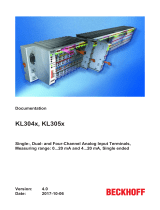 Beckhoff KL3002 Documentation
Beckhoff KL3002 Documentation
-
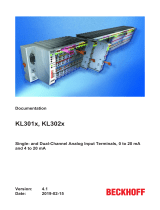 Beckhoff KL3022 Documentation
Beckhoff KL3022 Documentation
-
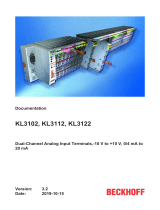 Beckhoff KL3122 Documentation
Beckhoff KL3122 Documentation
-
Beckhoff KL4021 Operating Instructions Manual
-
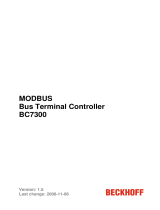 Beckhoff BC7300 User manual
Beckhoff BC7300 User manual
-
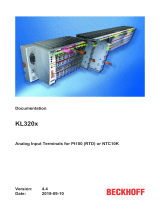 Beckhoff KL3201 Documentation
Beckhoff KL3201 Documentation
-
 Beckhoff FC2002 Documentation
Beckhoff FC2002 Documentation
-
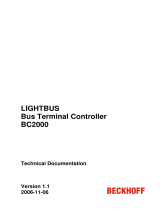 Beckhoff BC2000 Technical Documentation Manual
Beckhoff BC2000 Technical Documentation Manual
-
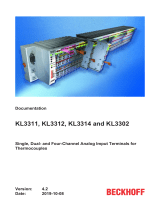 Beckhoff KL3312 Documentation
Beckhoff KL3312 Documentation
-
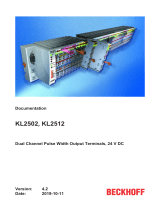 Beckhoff KL2502 Documentation
Beckhoff KL2502 Documentation
Other documents
-
Micro Motion Modbus Interface Tool: Integer Scaling Owner's manual
-
Kollmorgen AKT-ENC-000-000 Installation guide
-
Kollmorgen AKT-PRB-000-000 Installation guide
-
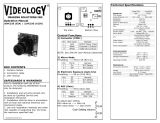 Videology 20VC335 EIA Operating instructions
Videology 20VC335 EIA Operating instructions
-
Sixnet BEP Reference ument User manual
-
Leuze electronic AMS 200 Technical Description
-
GW Instek SPD-3606 User manual
-
Pepperl+Fuchs U-P6-B5-V Owner's manual
-
Pepperl+Fuchs IPT1-FP Owner's manual
-
Schneider Electric INTERBUS Basic Network Interface Module User manual































